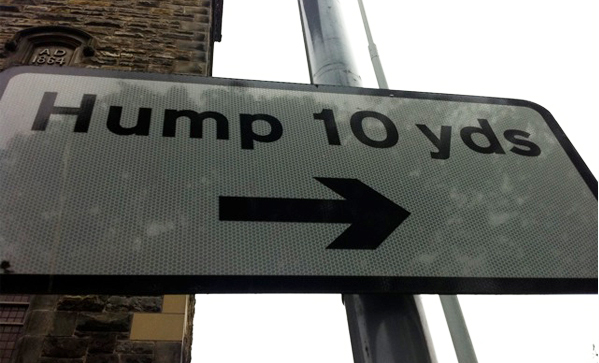Friend, you have to be crazy to drive in London, what with the toll-necessitating traffic, the incomprehensible bends and loops of the city’s post-Roman unplanned urban growth, and those socially downtrodden looters from deprived neighbourhoods setting your car on fire. But if you have a yen for thrills, a motoring holiday (we call it a “driving vacation”) in rural Britain always satisfies. This year, my clan was in Scotland for a fortnight (we call it “two weeks”), roaming on the edge of the highlands. For the umpteenth time, I relearned five things you should know about driving in the U.K.
First and most obvious, everything’s on the other side. But everything! You shift gears the other way. Older cars even roll down the windows backwards. When you reverse, you instinctively look over your right shoulder and — instinct is useful but stupid sometimes — continue rolling your head right around à la Linda Blair. It takes a few miles (they have yet to adopt metric) before you realize you have two other mirrors on your left. It strikes you as wasteful.
When there’s traffic, it’s much easier to remember to keep right. When there isn’t much, you may drift. Until there is. Snap! This process repeats until you acclimatize or collide.
It always requires some time to adjust, regardless of how many times you’ve visited. I lived in Edinburgh for a year and still can’t tell my left from right for the first three days I’m back in the U.K.
Second, if you don’t familiarize yourself with the traffic symbols beforehand, you’re downgraded from driver to rolling art viewer. A danger to yourself and everything else on the roads. They have weird names for what we call highways, none of which make sense: single carriageways, dual carriageways and motorways, all of which can have multiple lanes, few of which can shoulder much traffic.
And they all have signs you can’t understand. A lot of them are quite funny, one assumes unintentionally. For instance we saw, many times, urgently printed in capital letters and punctuated in the exclamatory “RED SQUIRRELS!” How can that possibly affect your drive?
A simpler yet vital example? There’s no yellow line demarcating two-way traffic; it’s white. So, no, Mr. Hungover Jetlagged Hoser, that white line doesn’t mean two lanes on a one-way road. Take just that one difference of yellow line to white (there are many) plus the aforementioned tendency to drift right and you have a very good reason to learn the basics. Enjoy. They’re weird.
Third, the roads are Toytown cute — often without room for two-way traffic. It’s charming, especially on a steep hill with lots of curves. Within fifteen minutes of a bustling town, your trip may be interrupted by a flock of sheep. Adorable.
But when you’re zipping along a black Hot Wheels track flanked by 20-foot stone walls, up a thirty-degree with a hairpin turn, then suddenly confronted with an 18-wheel lorry, chuntering along at 60 mph? In the blink of an eye, that olde quainte feeling transmogrifies to terror. This schizoid shift in mood is so sudden, it’s the closest you’ll ever experience to being someone else. Exhilarating stuff.
Fourth, the U.K. never had a Mike Harris who swept to office on the promise of abolishing traffic speeding cameras. You risk receiving a speeding ticket on your Visa card because there are traffic cameras everywhere, which may or may not be functioning. If you approach a curiously striped box and experience a flash in your eyes — I thought it was a tiny stroke or petit mal seizure — be sure to smile. You’ve just been photied (and nailed if you’re speeding).
Nothing’s shown up on the credit card yet, and it was a couple of weeks ago, so it seems everything’s fine. Still, good luck learning what exactly is the speed limit.
Fifth, the drivers aren’t rude. This may take the most getting used to.
Much of rural Britain is achingly lovely. The highlands more so, especially in good weather, which we had for a week. Steep green hills and ancient land-owning rights make for tight turns and bizarre decisions in the layout of your roads. So you’re baffled and possibly making poor decisions.
Fortunately, drivers are more courteous than we’re used to in Canada. (No, it’s not a Toronto thing: I’ve never seen less generous drivers than utterly empty Northern Ontario, suburban Montreal or Alberta prairie.) Despite the stereotype of Scots being grumpy drunks, they’re patient people and exceptionally generous on the roads. They never pass on the outside lane. They yield even if you were supposed to. They make eye contact in traffic and let you in when you indicate. They indicate.
All of which is good, given the four other adjustments you probably haven’t made.
——————–
Image courtesy of Steven Bochenek.


